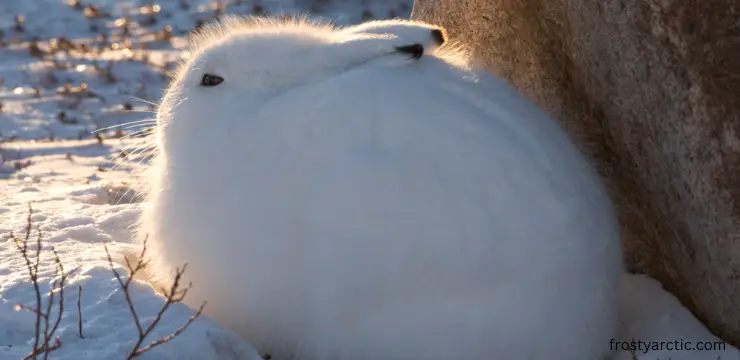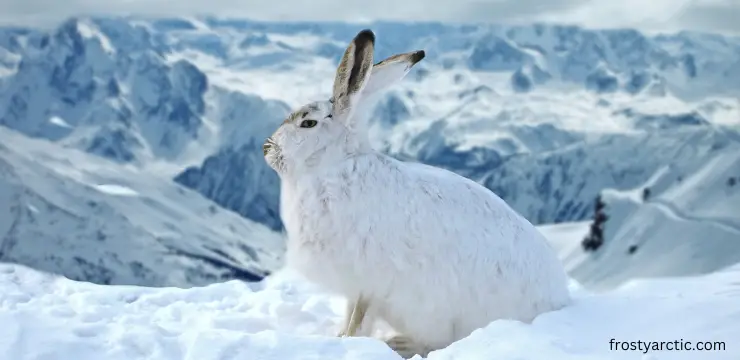The arctic hare’s physical characteristics enable it to adapt to its harsh, frigid environment. These physical characteristics include the creature’s nose, ears, and limbs. Its body structure and function also help it adapt to its environment.
While it accumulates fat to help it get through the long winters when there isn’t much to eat, it consumes grasses and other plants. These plants and grasses grow beneath the snow. It aids the arctic hare in swiftly adapting to its environment.
You will learn more about the arctic hare’s adaptation to its habitat and the elements that influence it in the sections of this article.
How Arctic Hare Adapt To The Cold Environment?
The arctic hare’s short ears and limbs are crucial to its ability to survive and adapt to its surroundings during the chilly winter months. You may also suggest that its tiny nose helps it adapt to its chilly surroundings.
Thick fur covers their body, 20% of which is fat. I believe it contributes to the hare’s constant, ideal body temperature.
Arctic hares are known to dig burrows to survive when the surrounding environment is extremely cold. They do this because they find the procedure to be quite straightforward.
The arctic hares can hide in the burrows from other creatures that could try to attack them. Except for a female arctic hare nursing baby hares, you can find only one hare in a burrow.
Arctic hares move in large groups known as droves when the temperature drops significantly. The drove keeps them warm and keeps any potential attackers at bay. Over a hundred hares can be in a drove.
How Arctic Hare Adapt To The Summer Environment?
In the summer, Arctic hares shed their thick coats, which I think helps them blend in with their environment because of the color. In the sweltering summer, their thick fur keeps them cool. All of their modifications enable them to endure the arctic’s severe and unreliable weather conditions in the summer.
Since they live at the base of big rocks, detecting arctic hares in groups looking for cover from the summer heat is impossible. It, in my opinion, is due to the coolness it bestows upon them.
You can see them alter their positions to stretch out on the ground when the temperature rises in May. They do this so they may sense the ideal temperature of their resting location.
Also See: What Do Arctic Hares Eat?
How Do Arctic Hare Adapt To Their Habitat?
Arctic hares use their physical characteristics to adapt. Snow serves as a food source and a source of moisture for hares. They use it to adapt to their surroundings, which, from my perspective, aids them in cold, snowy regions with abundant vegetation. The hares use their little ears to pick up on the nearby activity and food sources.
In addition, you can recognize Arctic hares by their feeding and digging behaviors. Arctic hares utilize their powerful hind legs to dig out burrows and search for food in the snow. The hares are, by nature, territorial. They will engage in combat to defend their food source from other animals.
They can endure low temperatures of -50 °C since they generally live in places where there is snow and ice.
They can flee from predators quickly while hopping on their hind legs or disperse in large groups to confuse the attackers.
How Arctic Hare Adapt To Food Habits?
Arctic hares must adjust to various times and seasons, as well as the types of food that are available at certain times.
Arctic hares eat a variety of fruits and vegetables in the winter. Given that they have easy access to tree barks, roots, berries, leaves, and even tree buds , I believe they have a wide range of possibilities.
However, they might need to dig through the snow to get fruits.
They must consume as much as possible to keep and stay healthy until the following winter season as the month’s pass and winter gradually ends.
Since less food is available in the summer, arctic hares can choose from mosses, lichens, and woody plants. They may have to turn to eat the insides of deceased animals during the summer due to a lack of food.
When you observe an arctic hare eating a decomposing animal, you shouldn’t be frightened as it is completely normal.
Also Read: Amazing Fun Facts about an Arctic Hare!
How Arctic Hare Adapt To Breeding?
A female arctic hare gives birth to five to six young hares once a year during the breeding season. When giving birth, they create a depression on the ground or beneath the rocks where they reside. They then line the sides with fur, moss, or grass and use it as a nursery.

Until the ninth week, when they are weaned and given the freedom to survive on their own, the female hare, or mother, departs them for more than 18 hours. She only returns to provide them with milk.
When the arctic hares are breeding, you may see them disperse while a male and female team up in anticipation of mating. The male arctic hare departs the female after they find an area to mate. I think male arctic hares can mate with more than one female. It is due to the propensity of arctic hares to multiply quickly and increase in population.
How Do Arctic Hares Keep Protection From Predators?
The arctic hare can escape predators attempting to hurt it thanks to its incredible speed. They can move at a pace of roughly forty miles per hour.
You can see this speed when the arctic hares scatter and run in great numbers to confuse the predators.
Additionally, I think that their thick fur helps animals blend in with their surroundings. It also serves as a defense technique against predators.
In the winter, their bright white coat helps them blend in with the snow. In the summer, their brown fur helps them blend in with the surrounding terrestrial habitat.
The hare’s colors turn to a blue-gray hue in the spring to resemble nearby rocks and flora.
How Does An Arctic Hare Change Color?
Arctic hares also use color variation in their fur to adapt successfully to their surroundings. Their fur turns completely white in the winter, as you can see. They are occasionally gray or brown in the summer.
So how can the arctic hare change the color of its fur?
The retina and brain communicate when a season is about to change, which prompts the hare to change its fur color.
For instance, the retina of the arctic hare notifies the brain when winter is approaching that it needs to replace the body’s brown or gray fur.
As I mentioned, this helps them blend with their habitats in any season. Therefore the periodic modification and replacement of fur are vital for their adaptations. It may aid them in avoiding predators.
Most of the time, an arctic hair will wear its brown or gray coat because summer lasts longer than winter.
Why Do Arctic Hares Have White Fur In Winter And Brown Fur In Summer?
In the summer, the arctic hare has white fur to help it blend in with its surroundings and hide. In the winter, when it is white, it flawlessly blends in with the snow to evade predators that might want to kill it.
It would be quite simple for predators to identify and damage it if it kept its summery grey coat.
Likewise, it is the same during the winter.
Predators like eagles easily harm the arctic hare. Because this color blends well with the surroundings of the arctic hare’s environment, it hides from predators. It does this by turning brownish or grayish in the summer.
The arctic hare is kept warm by the white color when the winters are very bitter. The hare’s fur color changes seasonally because of this.
It’s also crucial to be aware that arctic hares in the northern regions never change the color of their fur. It, in my opinion, is because the weather in those places doesn’t typically change.
Physical Adaptation of Arctic Hare
The physical modifications that Arctic hares have made to cope with the cold are widely recognized. Its fur grows in two layers and is two to three times as thick as that of a normal hare.
Long, dense, downy hair makes up the top layer, while shorter, coarser hair makes up the bottom layer, traps air close to the skin, and warms the animal.
Their feet are big and stubby, which allows them to walk on snow without sinking in, as you can see. Arctic hares can sprint at more than forty miles per hour and are well-adapted to living in freezing climates.
In addition to having larger ears than other common hares, arctic hares have a different unique gland in their ears known as “the preen gland.” According to what I understand, this gland secretes oil that keeps their fur smooth and keeps it from matting.
They can keep a higher body temperature and conserve energy when it’s chilly outside. They can do this thanks to the adaptations made to their kidneys’ capacity to hold urea.
Arctic hares are extremely agile and can jump 7 feet in the air. They are renowned for making lengthy leaps to escape wolves, bears, and other predators.
Conclusion
The arctic hare has physical features which help it adapt to its surroundings. It also has behavioral patterns which help it adapt and survive in any environment it finds itself.
Their body structure also helps them when doing their activities. The tiny snout of Arctic hares makes it easier for them to find food.
The thick fur of arctic hares contains 20% fat. This fat contributes to the hare’s consistent, optimal body temperature and aids in keeping it warm and insulated.



10 thoughts on “How Arctic Hares Adapt the Cold and Harsh Conditions?”